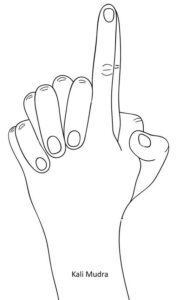Kali Mudra
Introduction
Kali Mudra is a powerful yogic hand gesture named after the fierce goddess Kali, the embodiment of transformation, destruction of negativity, and inner power. This mudra symbolizes cutting through illusions, channeling strength, and awakening dormant energy. It is often practiced in meditation, pranayama, or dynamic yoga flows to increase focus, empowerment, and energetic purification.
Meaning
Kali – Goddess of time, power, transformation, and liberation from ego and fear.
Mudra – Sacred hand gesture or seal that directs energy flow in the body.
Thus, Kali Mudra means “the gesture that invokes the fierce transformative power of Goddess Kali”, helping practitioners remove inner obstacles, fear, and negativity.
How to Perform (Method of Practice)
Step-by-Step Instructions:
Sit in Sukhasana (Easy Pose), Padmasana (Lotus Pose), or stand firmly in Tadasana (Mountain Pose).
The index finger points upward with the interlace middle, ring and small fingers; left thumb crossed from the right side; place the hands in front of the chest or above the head.
Hold the hands in front of the chest, solar plexus, or overhead depending on the intensity of practice.
Close your eyes, breathe deeply, and visualize fiery energy burning away fear and negativity.
Maintain focus at the Ajna Chakra (third eye) or Manipura Chakra (solar plexus) for empowerment.
Practice Tip: When used in meditation, chant silently or aloud “Om Kali Ma” for deeper connection.
Benefits
Physical Benefits:
Stimulates energy flow throughout the body.
Activates core muscles and improves posture when held overhead.
Improves circulation and breath awareness.
Mental & Emotional Benefits:
Reduces fear, insecurity, and mental stagnation.
Increases confidence, inner strength, and determination.
Provides emotional release and stress relief.
Spiritual Benefits:
Awakens kundalini shakti (dormant energy at the base of the spine).
Supports deep meditation and inner purification.
Invokes the transformative energy of Kali, aiding spiritual growth.
Contraindications
People with shoulder, arm, or wrist injuries should avoid holding the mudra overhead; keep it at chest level instead.
Those with high blood pressure or migraines should avoid raising arms above the head for long durations.
Not recommended during periods of extreme emotional imbalance without guidance.
Anatomy & Physiology
Musculoskeletal: Engages finger flexors (through interlacing), index finger extensors, shoulder and chest stabilizers.
Respiratory: Encourages deeper diaphragmatic breathing.
Circulatory: Promotes blood flow toward the upper body.
Endocrine: May stimulate adrenal and solar plexus region, linked to willpower.
Kinesiology
Involves isometric engagement of finger muscles through interlacing.
Extension of index fingers creates a symbolic “sword of energy” channel.
Overhead position engages deltoids, trapezius, and core stabilizers, strengthening posture.
Neurology
Activates somatosensory and motor cortex through precise finger positioning.
Calms the amygdala, reducing fear and stress responses.
May enhance alpha brainwave activity, improving focus and meditation depth.
Duration of Practice
Beginners: 3–5 minutes, once or twice daily.
Intermediate: 10–15 minutes, can be combined with pranayama.
Advanced: Up to 20 minutes in meditation or dynamic yoga sequences.
Best practiced in the morning or during moments of low energy or fear.
Counter Mudra
Anjali Mudra (Prayer Gesture): Balances and grounds after the intensity of Kali Mudra.
Gyan Mudra: Helps restore calm focus after energizing practices.
Conclusion
Kali Mudra is a dynamic and empowering yogic gesture that channels the fierce energy of Goddess Kali, helping practitioners overcome fear, negativity, and inner obstacles. It strengthens body, mind, and spirit, making it ideal for moments when one needs courage, clarity, or transformation. Practiced with awareness, it becomes a powerful tool for personal empowerment and spiritual awakening.
FAQ
Q1: Can beginners practice Kali Mudra?
Yes, but start with shorter durations and keep hands at chest level to avoid strain.
Q2: Can it be practiced lying down?
No, it is best done sitting or standing with spine erect.
Q3: Is chanting necessary?
Not required, but chanting mantras like “Om Kali Ma” enhances the spiritual effect.
Q4: Can children practice it?
Yes, for short durations with guidance.
Q5: Does it help with fear and anxiety?
Yes, it helps release fear and builds courage by activating the solar plexus chakra.
References
Swami Satyananda Saraswati – Asana, Pranayama, Mudra, Bandha.
Gertrud Hirschi – Mudras: Yoga in Your Hands.
B.K.S. Iyengar – Light on Yoga.
Swami Niranjanananda Saraswati – Yoga Darshan.
Contemporary articles on mudra therapy and meditation neuroscience.

